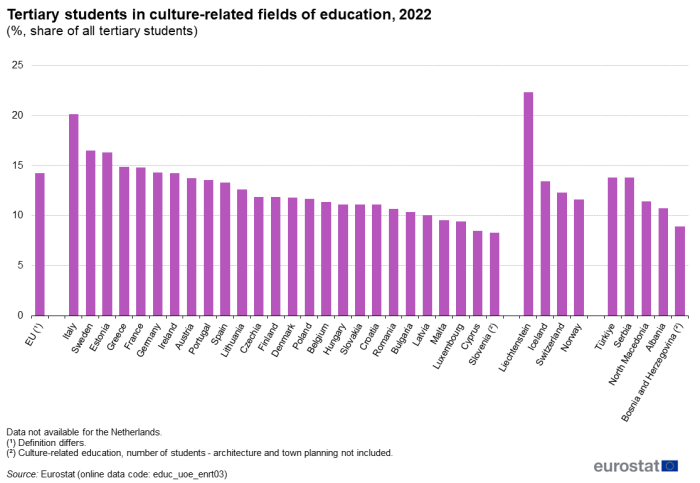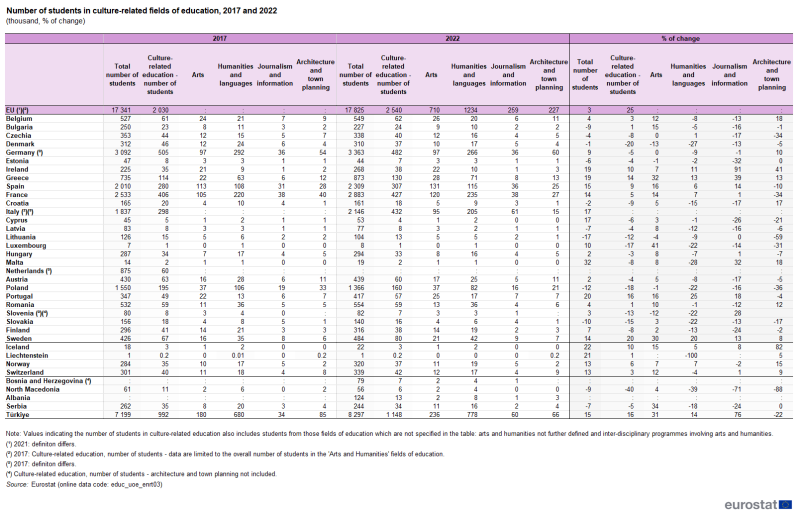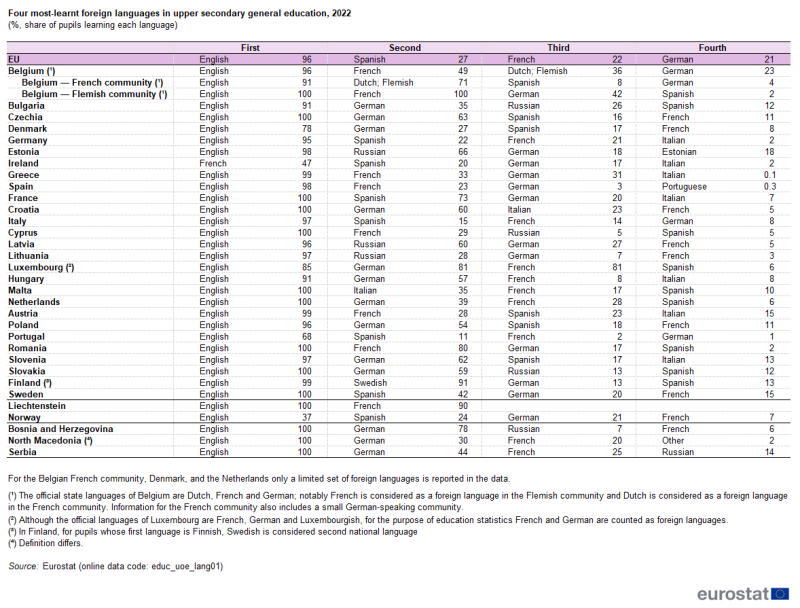Culture statistics - culture-related education
Data extracted in May 2024.
Planned article update: June 2025.
Highlights
Tertiary students in culture-related fields of education, 2022
This article forms part of the Culture statistics online publication. It describes two areas that link education with culture:
- tertiary students who are studying culture-related fields
- the role played by education in facilitating cultural exchanges, for example, by learning foreign languages.
Full article
Defining tertiary students in culture-related fields of education Universities and similar institutions provide tertiary education within the higher education sector. According to the international standard classification of education (ISCED), it is classified as ISCED levels 5 to 8.
The following fields are considered to be culture-related:
- arts
- humanities and languages
- journalism and information
- architecture and town planning.
Tertiary students – around 2.6 million studying in culture-related fields across the EU in 2022
In 2022 there were around 2.6 million students in the EU studying in culture-related fields. This equated to 14.3 % of all tertiary students in the EU (see Figure 1). The share of students in culture-related fields was equal or above the EU average in seven EU Member States. The largest share was in Italy at 20.1 %, followed by Sweden, Estonia, Greece, France, Germany and Ireland. The smallest shares of tertiary students following culture-related fields were in Malta (9.6 %), Luxembourg (9.4 %), Cyprus (8.5 %) and Slovenia (8.3 %).

(%, share of all tertiary students)
Source: Eurostat (educ_uoe_enrt03)
Between 2017 and 2022 the number of people studying arts increased the most, among all those pursuing culture-related fields of education
Table 1 compares the number of students in 2022 with those in 2017 at national level. It shows that in this timeframe, of the 25 EU Member States with available data, ten saw an increase in the number of students pursuing culture-related fields (data for Italy and the Netherlands cannot be compared). An increase in the total number of tertiary students was witnessed in 17 EU Member States.
The highest increases in the number of students in culture-related fields were recorded in Sweden (20 %) and Portugal (16 %). In addition to these, an increase in the number of students in culture-related fields of education was observed in seven other EU countries. Conversely, Denmark (-20 %), Poland (-18 %) and Luxembourg (-17 %) recorded the largest decreases. In Denmark and Poland the number of students decreased in all culture-related fields of education.
The highest increase in the number of students was observed in arts. This growth concerned 18 out of 25 EU countries. Luxembourg, Greece and Sweden saw the most significant growth in arts students, with 41 %, 32 % and 30 %, respectively. 'Journalism and information' saw an increase in ten EU countries, 'architecture and town planning' in nine countries and 'humanities and languages' in seven countries. The most significant decreases among all culture-related fields of education were seen in 'architecture and town planning', dropping by 59 % in Lithuania and by 36 % in Poland, between 2017 and 2022.

(thousand, % of change)
Source: Eurostat (educ_uoe_lang01)
In most EU countries, the highest number of students in culture-related tertiary education were enrolled in humanities and languages
Figure 2 provides a breakdown of culture-related fields that tertiary students followed in 2022. 'Humanities and languages’ was the most common field of study in the EU (more than 1.2 million tertiary students), which was equivalent to almost half (48.6 %) of all tertiary students in culture-related disciplines. Otherwise, 27.9 % of the EU students in culture-related fields in 2022 were enrolled in arts, while 10.2 % were studying journalism and information studies, 8.9 % were studying architecture and town planning and 4.4 % were studying in other fields related to arts and humanities (the latter include arts and humanities not further defined, together with interdisciplinary programmes and qualifications involving arts and humanities).
Humanities and languages account for the greatest share of tertiary students in culture-related fields. In 2022, this was observed in 19 of the 26 EU Member States (data not available for the Netherlands), with the greatest share recorded in Luxembourg (76.8 %), followed by Romania (61.0 %) and Germany (55.3 %). In the remaining seven Member States (where humanities and languages were not the most common subjects), arts had the greatest share of tertiary students in culture-related fields. Ireland was the only EU Member State where ’arts’ was chosen by more than half (58.0 %) of all students in culture-related fields.
The largest shares of tertiary students in journalism and information studies were reported in Slovakia (26.9 %), followed by Croatia and Lithuania (both at 17.0 %), while the greatest share for town planning and architecture were reported in Austria (17.9 %) and Belgium (16.9 %).

(%, share of all tertiary students in culture-related fields of education)
Source: Eurostat (educ_uoe_enrt03)
Women accounted for most tertiary students in each of the culture-related fields of study
In 2022, there were more female than male tertiary education students in the EU studying culture-related fields, with women accounting for 64.6 % of the total (see Figure 3). The share of women was slightly greater among those studying journalism and information studies (68.93 %) and humanities and languages (66.8 %), while the gap between the sexes was much less pronounced for those studying architecture and town planning – where women accounted for 55.5 % of all students.

(%)
Source: Eurostat (educ_uoe_enrt03)
Foreign languages
In 2022, secondary school pupils in Luxembourg were taught at least two foreign languages on average
- In 2022, the average number of foreign languages learnt by pupils in lower secondary education (ISCED level 2) was higher than two in Luxembourg (2.3), Finland (2.2), Malta and the Netherlands (2.1). Ireland (0.9) recorded the lowest average number of foreign languages at ISCED level 2.
- The average number of foreign languages studied by pupils in upper secondary general education (ISCED level 3) peaked at 2.6 in Luxembourg. It was higher than two in Finland, Belgium and Estonia. By contrast, Portuguese pupils in upper secondary general education were studying just 0.8 foreign languages on average.
Generally, there was less focus on teaching foreign languages in vocational compared with upper secondary general education. This pattern was repeated in 23 of the 26 EU Member States for which a comparison was available (the comparison was not possible for Ireland). Cyprus and Romania were the only EU countries where pupils in upper secondary vocational education studied, on average, as many foreign languages as those in upper secondary general education (1.4 and 2.0, respectively), while Portugal was the only Member State where the average was higher for pupils in upper secondary vocational education. The average number of foreign languages studied by pupils enrolled in upper secondary vocational education in Portugal, Hungary, the Netherlands, Estonia, Greece, Lithuania, Spain, Germany and Denmark was less than 1.0 (see Figure 4).

(number)
Source: Eurostat (educ_uoe_lang03)
English is the most common foreign language taught to upper secondary pupils in the EU
Table 2 shows that English was by far the most taught foreign language in upper secondary general education in the EU. The next most taught foreign languages were Spanish, French and German.
In 2022, across most EU Member States, 96 % of upper secondary general education pupils were learning English as a foreign language. This concerned all pupils in Malta, the Netherlands and Sweden. The exceptions, where pupils learnt English as a foreign language was less than 90 %, were Luxembourg (85 %), Denmark (78 %) and Portugal (68 %).
In addition to English, looking at the next most frequently studied foreign language in upper secondary general education in each of the EU Member States, German appears 10 times, French 8 times and Spanish 6 times. Close geographic and historical ties also influence which foreign languages pupils learn. In 2022, the second most frequently taught foreign language in the Baltic Member States was Russian, in Malta it was Italian, and in Finland Swedish.

(%, share of pupils learning each language)
Source: Eurostat (educ_uoe_lang01)
Data sources
The education statistics presented in this article draw principally on a joint exercise run by UNESCO, the OECD and Eurostat known as the UOE data collection. It provides annual statistics on the participation in and the completion of education programmes by pupils and students, as well as data on education staff and education spending.
Tertiary students in culture-related fields of education
The international standard classification of education (ISCED) is the reference classification for organising educational programmes and related qualifications by levels and fields. ISCED 2011 took into account a range of changes to education systems (for example, those relating to the Bologna process in tertiary education, or the expansion of education programmes for very young children).
Levels of education are classified by ISCED 2011 as follows:
- ISCED 0: early childhood education;
- ISCED 1: primary education;
- ISCED 2: lower secondary education;
- ISCED 3: upper secondary education;
- ISCED 4: post-secondary non-tertiary education;
- ISCED 5: short-cycle tertiary education;
- ISCED 6: bachelor's or equivalent level;
- ISCED 7: master's or equivalent level;
- ISCED 8: doctoral or equivalent level.
ISCED also classifies fields of education and training (ISCED-F 2013). Within this classification, four main fields have been identified as being related to culture:
- arts (fine arts, music and performing arts, audio-visual techniques and media production, design, craft skills);
- humanities (religion, foreign languages, history and archaeology, philosophy and ethics);
- journalism and information (journalism and reporting, library, information, archiving);
- architecture and town planning.
Foreign languages
Within the UOE data collection, Eurostat gathers information on foreign language teaching in primary and secondary educational programmes. The educational curriculum drawn up in each country defines the languages considered as foreign languages. Regional languages are included if they are considered as alternatives to foreign languages. Non-nationals studying their native language in special classes or those studying the language(s) of the host country are excluded. Foreign languages learnt in formal education include all modern languages taught as foreign languages; ancient Greek, Latin, Esperanto and sign languages are excluded. Only foreign languages studied as compulsory subjects or as compulsory curriculum options are included.
Context
Culture is one of Europe's greatest assets: it is a source of values and identity and creates a sense of belonging. It also contributes to wellbeing, social cohesion and inclusion. The cultural and creative sectors can trigger economic growth, job creation and international trade.
This is why culture is becoming more important in the EU. In line with Article 167 of the Treaty of Lisbon, the EU 'shall contribute to the flowering of the cultures of the Member States, while respecting their national and regional diversity and at the same time bringing the common heritage to the fore'.
The EU supports these objectives through the Creative Europe programme and a number of policy actions included in the work plan for culture (2023-2026) setting the main priorities for European cooperation in cultural policymaking: empowering the cultural and creative sectors; enhancing cultural participation and the role of culture in society; unleashing the power of culture; and strengthening the cultural dimension of the EU external relations. According to the work plan, implementation should also be supported by optimised use of quality data and statistics.
Direct access to
- Culture (all Statistics Explained articles on culture)
- Education and training in the EU - facts and figures (article on Statistics Explained)
- Learning mobility statistics (article on Statistics Explained)
- Foreign language learning statistics (article on Statistics Explained)
- Participation in education and training (educ_part)
- Pupils and students - enrolments (educ_uoe_enr)
- Tertiary education (cult_uoe_enrt)
- Students enrolled in tertiary education by education level, programme orientation, sex and age (educ_uoe_enrt02)
- Students enrolled in tertiary education by education level, programme orientation, sex and field of education (educ_uoe_enrt03)
- Tertiary education (cult_uoe_enrt)
- Pupils and students - enrolments (educ_uoe_enr)
- Participation in education and training (educ_part)
- Languages (educ_lang)
- Language learning (educ_uoe_lang)
- Pupils by education level and modern foreign language studied - absolute numbers and % of pupils by language studied (educ_uoe_lang01)
- Average number of foreign languages studied per pupil by education level (educ_uoe_lang03)
- Language learning (educ_uoe_lang)
- Languages (educ_lang)
- Culture_statistics online publication
- Guide to Eurostat culture statistics — 2018 edition
- Guide to Eurostat culture statistics — 2018 edition
- European statistical system network on culture (ESSnet-Culture final report (2012))
- Education administrative data from 2013 onwards (ISCED 2011) (ESMS metadata file — educ_uoe_enr_esms)
- ISCED 2011 operational manual – Guidelines for classifying national education programmes and related qualifications
- UNESCO OECD Eurostat (UOE) joint data collection – methodology (article on Statistics Explained)
- UOE data collection on formal education – Manual on concepts, definitions and classifications – 2021 edition
- Regulation (EC) No 452/2008 of the European Parliament and of the Council of 23 April 2008 concerning the production and development of statistics on education and lifelong learning
- Regulation (EU) No 2021/818 of the European Parliament and of the Council of 20 May 2021 establishing the Creative Europe Programme (2021 to 2027) and repealing Regulation (EU) No 1295/2013
- European Council work plan for Culture (2023-2026)
- European Council work plan for Culture (2019-2022)
- European Council work plan for Culture (2015-2018)
- Communication from the Commission to the European Parliament, the Council, the European Economic and Social Committee and the Committee of the Regions on a European agenda for culture in a globalising world (COM(2007) 242)